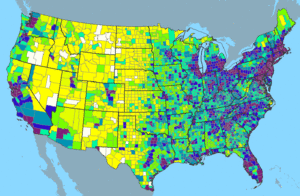Buffalo Commons facts for kids
The Buffalo Commons is a big idea about how to use a large part of the Great Plains in the central United States. It suggests turning about 139,000 square miles (360,000 km²) of dry land back into its natural state: a native prairie. The main goal is to bring back the American bison (often called "buffalo"), which used to roam freely there. This idea would affect ten states: Montana, Wyoming, Colorado, Oklahoma, New Mexico, Texas, North Dakota, South Dakota, Nebraska, and Kansas.
Contents
Why the Buffalo Commons Idea Started
The idea for the Buffalo Commons came from two people, Frank J. Popper and Deborah Popper. They wrote about it in 1987. They believed that the way people were using the drier parts of the Plains wasn't working well for the long term. They saw that farming in these areas was very difficult because of the dry climate.
Problems on the Plains
The Poppers pointed out that big problems like the Dust Bowl (a time in the 1930s when severe dust storms hit the Plains) and many people moving away show that farming might not be the best use for all this land. Since 1920, about a third of the people living in rural areas of the Plains have moved away.
Many parts of the Great Plains have very few people living there, sometimes fewer than 6 people per square mile. Some areas even have fewer than 2 people per square mile! This means there are many "ghost towns" (abandoned towns) in states like Kansas. The Poppers suggested that the number of people leaving the Plains was increasing.
How the Buffalo Commons Could Work
The Poppers suggested that parts of the Plains could slowly change from being used for farming and ranching. They imagined a huge area of native grassland, possibly 10 to 20 million acres (40,000 to 80,000 km²) in size.
One way this could happen is through voluntary agreements. Farmers and ranchers could choose to work with groups like the United States Forest Service. They would be paid for what they would have grown over the next 15 years. During that time, they would plant native Shortgrass prairie grasses and other plants. After this period, the land could be bought, and the original owners might even keep a small piece of land (about 40 acres).
The Poppers later realized that many different groups would need to be involved, not just the government. They now see that local communities, non-profit groups, and Native American nations all have important roles.
What Happened Next

The idea of the Buffalo Commons got a lot of attention. Some states and Native American tribes had already started bringing bison back to their lands.
At first, many people living on the Plains didn't like the idea. They thought it meant they would be forced to leave their farms. They also pointed out that fewer people were needed for farming because of new machines, not just because farms were failing. However, those who supported the Buffalo Commons explained that the plan would be completely voluntary.
Changes and Partnerships
Many experts now believe that parts of the Buffalo Commons idea will happen anyway, even without the national government being directly involved. States, local community groups, and Native American nations have found that the concept fits with some of their own plans for the future. They are working together or on their own to help the environment and make their communities stronger.
The Poppers have seen many partnerships form, including private groups and non-governmental organizations. They compare the Plains to Northern New England, where many farms were abandoned in the 1830s. Over time, forests grew back and covered the old farmland.
Native American Involvement
One group whose population has actually grown on the Plains is various Native American nations. Some of these nations have started raising bison again. This is important for their traditional cultures, for tourism, and for the health of the environment.
In 1992, Native American tribes created the InterTribal Bison Cooperative. This group now includes 57 Native American governments in 19 states. They help train people to raise buffalo and manage tribal lands. They are working to bring back the buffalo's important place in their cultures. Since 1992, the number of buffalo on Native American lands has more than tripled. By 2009, these tribes managed about 15,000 bison. Other private owners and non-profit groups have also been raising bison. By 2001, the total number of bison on the Plains had grown to 300,000.
A Changing View
As of 2009, the population in the high plains continued to decrease, and local economies were still shrinking. Also, a major water source called the Ogallala Aquifer was getting smaller faster than expected. Because of these changes, people's opinions about the Buffalo Commons have started to shift.
In November 2009, The Kansas City Star newspaper wrote an editorial that said the aquifer was almost empty. It also noted that the best thing about the high plains was its natural prairie. The editorial supported creating a million-acre (4,000 km²) Buffalo Commons National Park in western Kansas. Such a park could:
- Attract tourists, which would help local towns.
- Help the environment by storing carbon in the prairie.
- Protect America's natural and cultural history.


